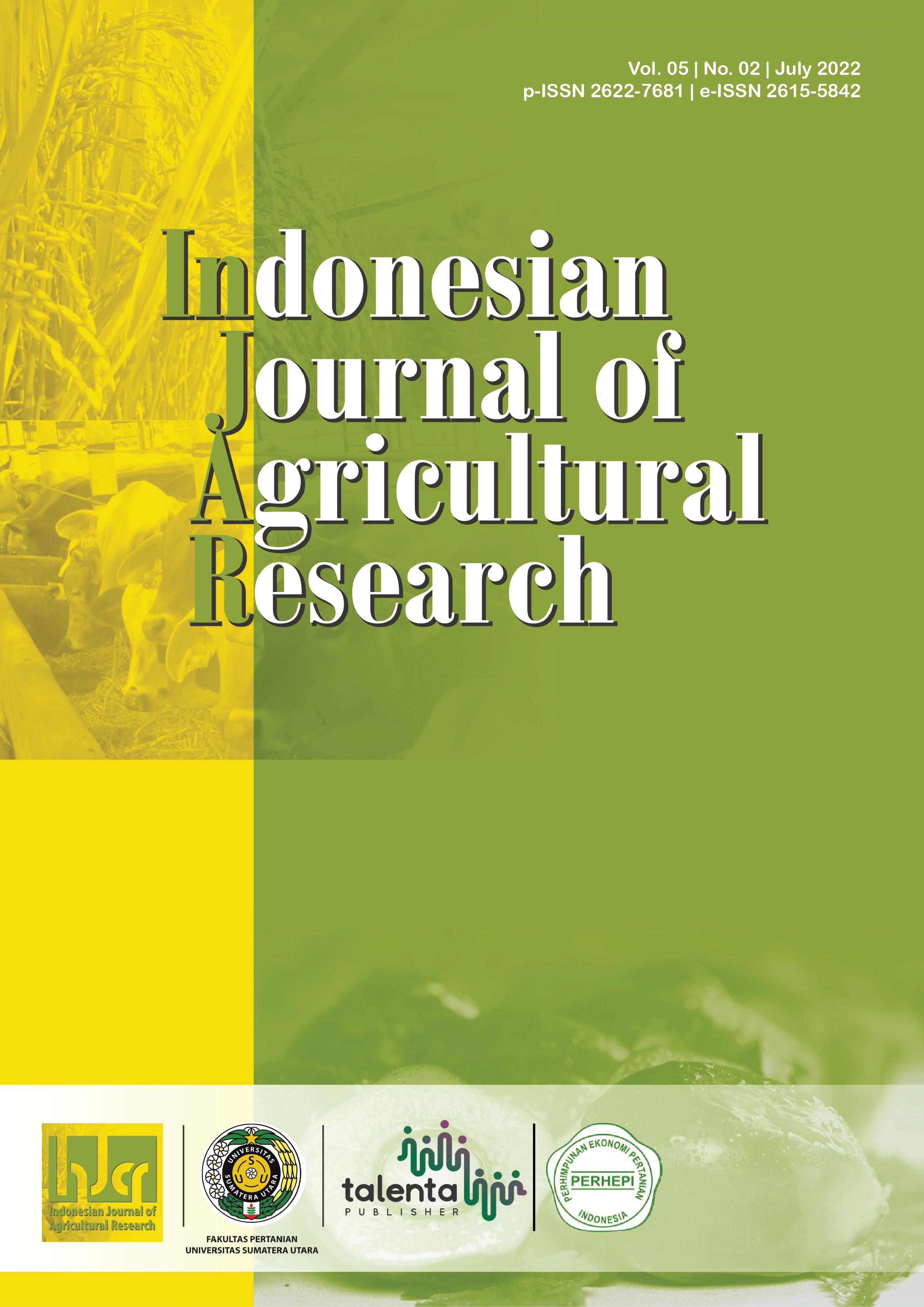Characteristics Physicals and Chemicals of Probiotic Drinks Soy-Yamghurt
DOI:
https://doi.org/10.32734/injar.v5i2.8310Keywords:
fermentation periods, probiotik drinks, soybean, soy-yamghurt, yam-beanAbstract
Soy-yamghurt is fermentation product of yam-bean extract and soybean extract made by adding bacterium Lactobacillus bulgaricus, Lactobacillus acidophilus and Streptococcus thermophillus which are commonly used in the process of making yoghurt. This study aims to determine the physical and chemical characteristics of soy-yamghurt probiotic drinks. The research used a completely randomized design factorial with two factors, i.e.: ratio of yam-bean extract with soybean extract (100%:0%; 75%:25%; 50%:50%; 25%:75%; 0%:100%) and fermentation periods (4 hours; 6 hours; 8 hours). The result showed that ratio of yam-bean extract with soybean extract had highly significant effect on color test value, viscosity, moisture content, protein content, total sugar content, reducing sugar content, starch content, and glucose content. In the meantime, the fermentation periods had highly significant effect on viscosity, moisture content, total sugar content, reducing sugar content, starch content, glucose content and had significant effect on color and protein content. Interaction between the two factors had a highly significant effect on viscosity, reducing sugar content and had significant effect on moisture content. Furthermore, the interaction had no significant effect on color, protein content, total sugar content, starch content, and glucose content. The best soy-yamghurt was produced with ratio of yam-bean with soybean extract 50:50 fermented for 6 hours.
Downloads
References
J. Silalahi, D. Nadarasoni, and Y. C. E. Silalahi, “The effect of storage condition on antioxidant activity of probiotics in yogurt drink,†Asian J Pharm Clin Res, vol. 11, no. 12, pp. 280-283, 2018.
Y. Trisnawita, J. Silalahi, and S. M. Sinaga, “The effect of storage condition on viability of lactic acid bacteria in probiotic product,†Asian J Pharm Clin Res. vol. 11, pp. 84–6, 2018.
Amirdivani, dan S. Baba, “Changes in yoghurt fermentation characteristics, and antioxidant potential and in vitro inhibition of angiotensin-1 enzyme upon the inclusion peppermint, dill and basil,†Food Sci Technol, vol. 44, no. 6, pp. 1458-1464, 2011.
M. M. Cuenca, A. L. Caisedo, S. Holguin, S. Martha, Quicazan, and C. Martha, “Soymilk and milk fermentation using and immobilized lactic culture,†Food science and technology institute, National of Colombia, Bogota, 2011.
R. Irkin, and U. V. Eren, “Research about viable Lactobacillus bulgaricus and Streptococcuc thermophylus number and food science in the market yoghurt,†World J. of Dairy, vol. 3, no. 1, pp. 25-28, 2008.
Silalahi, J., Functional Food. Yogyakarta: Kanisius, 2006.
E. Lukitaningsih and U. Holzgrabe, “Bioactive compounds in bengkoang (Pachyrhizus erosus) as antioxidant and tyrosinase inhibition agents,†Indonesian J. Pharm, vol. 25, no. 2, pp. 68-75, 2014.
AOAC. “Official methods of analysis of the association of analytical,†Washington: Chemists, 1995.
A. Budianto, “The method of determining the viscosity coefficient of a liquid is by using Stokes law linear regression,†National Seminar IV, SDM Nuclear Technology, pp. 157-166, 2008.
J. B. Hutching, Food Color and Appearance. NY: Springer New York, II Edition, 1999.
M. Dubois, K. A. Gilles, J. K. Hamilton, P. A. Rebers, and F. Smith, “Colorimetric method for determination of sugars and related substances,†Analytical Chemistry, vol. 28, no. 3, pp. 350-356, 1956.
A. Apriyantono, D. Fardiaz, N. L. Puspitasari, Sedarnawati, and S. Budiyanto, “Food analysis laboratory instructions,†Inter-University Center for Food and Nutrition, Bogor Agricultural University, 1989.
S. Sudarmadji S, H. Bambang, and Suhardi, Analytical Procedures for Foodstuffs and Agriculture. Bandung: Angkasa, 1997.
F. G. Winarno, S. Fardiaz, and D. Fardiaz, Introduction to Food Technology. Jakarta: Gramedia, 2003.
J. B. Harborne, “Phytochemical methods; modern determination analyzing plants,†second issue, translation of Kosasih Padmawinata and Iwang Soediro, ITB, Bandung, 1987.
A. W. Nugroho, “Study of making probiotic beverage pear (Pyrus L.) Ya-Lie variety with Lactobacillus plantarum B2 isolate (skim milk and sucrose concentration study),†Universitas Brawijaya. Malang, 2012.
P. C. Mijayani, 2008. “Making green bean milk kefir (Phaseolus radiatus L.) study of the effect of skim milk concentration and fermentation time on physical, chemical and organoleptic parameters. Universitas Brawijaya. Malang, 2008.
D. A. Herawati and D. A. A. Wibawa, “Pengaruh konsentrasi susu skim dan waktu fermentasi terhadap hasil pembuatan soyghurt,†Jurnal Ilmiah Teknik Lingkungan, vol. 2, no. 1, pp. 48-58, 2011.
R. Sunarlim, H. Setiyanto, and M. Poeloengan, “The effect of the combination of starter bacteria Lactobacillus bulgaricus, Streptococcus thermophillus, and Lactobacillus plantarum on the quality properties of fermented milk,†National Seminar on Animal Husbandry and Veterinary Technology, 7 (07): 270-278, 2007.
S. Mulyani, I. Indratiningsih, and Y. B. Pramono, “Peningkatan kualitas fisik yoghurt isntan hasil spray drying dengan aditif penginstan,†Animal Production, vol. 6, no. 1, 2004.
R. R. Widyani and T. Suciaty, Principles of food preservation. Cirebon: Swagati Press, 2008.
Sofyan, The Benefits of Yam-bean for Health. Yogyakarta: Syura Media Utama Tensiska, 2010.
S. Koswara, “Soy milk is not inferior to cow's milk,†Department of Food Technology and Nutrition, Faculty of Agricultural Technology, Bogor Agricultural University, 2006.
D. Susanto and N. S. Budiana, Goat Milk. Depok: Penebar Swadaya, 2005.
L. Axelsson, Lactic Acid Bacteria: Classification and Physiology. In: S. Salminen, and A. Von Wrigh, (eds). Lactic Acid Bacteria: Microbiology and Functional Aspects 2nd Editionâ€, New York: Marcel Dekker Inc., 1-72, 1998.
Fratiwi, “Fermented kefir from nut milk,†Vis vitalis, vol. 1, no. 2, 2008.
Downloads
Published
How to Cite
Issue
Section
License
Copyright (c) 2023 Indonesian Journal of Agricultural Research

This work is licensed under a Creative Commons Attribution-ShareAlike 4.0 International License.



















